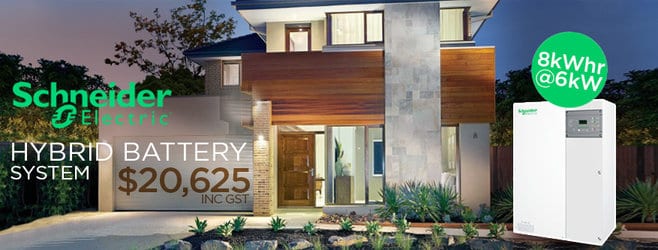2015 is surely bringing in the age of hybrid solar. In recent months we have seen the release of Samsung’s ESS system, SMA’s TL Hybrid combo and new models within Schneider Electric’s Conext range. There are also a plethora of other brands about to, or already hitting the market including Bosch, ABB Aurora and BYD.
What is Hybrid Solar and What are its Costs?
Hybrid solar is a typical pv system with the addition of batteries, often used to store excess power so that it can be used to offset peak load or night time use. It is generally not intended to take a household ‘off grid,’ however in many cases it has the capability to do so. To understand this in more detail lets look at some terminology.
Solar PV
Solar PV refers to the panels on your roof which are then ‘tied’ or ‘coupled’ to an inversion system on the ground. A ‘grid tie solar PV’ system is the technical term for your typical domestic or commercial solar system and is commonly made up of panels and a single inverter. These days it is also possible to purchase an AC solar system using micro inverters.
AC Coupled Hybrid
This refers to a standard grid tie system ‘coupled’ to a hybrid inverter, which then charges batteries and outputs to the home and/or grid. We expect this type of system to become extremely popular, as it will be a great way to upgrade from existing PV and it is also extremely cost effective as a new install.
DC Coupled Hybrid
This is where we run the solar PV into a regulator, which also acts as a battery charger. This then connects directly to the batteries, which are then connected to the hybrid inverter. This is your typical structure for a full off grid system.
So now that we’re all on the same page where to from here?
What is the right system for you? Which batteries should you use? Is it cost effective and why install hybrid?
For most people the common scenario is going to be an AC coupled system using a standard inverter, running into a hybrid unit such as the Schneider Conext XW+. A system like this can be selected as an add on, and allows for complete off grid functionality at a later date. There are a number of design considerations to look at when selecting a hybrid system. These can have a dramatic effect on operation so should be considered closely.
1 Peak Draw
This is the highest amount of power one expects to draw at any one point in time usually measured in kW or watts, but sometimes in amps. Since peak is a limiting factor in any hybrid or off grid installation it makes sense to ‘load shift’ devices, so that they’re not all on at once. For example one may tell the hot water system to heat, followed by the swimming pool to clean – all outside of peak (ie cooking hours). It may also be beneficial to change appliances such as stoves to gas, and it will certainly make sense to change lighting to LED. In saying that the latest XW+ can deliver a sustained load of 28A and handle a peak of 50A for up to 60 seconds and 35A for up to 30 minutes. This will handle the average home and for larger installations they can be chained together in bundles of up to 110kW three phase – enough to power a small community!
2 Storage Capacity
It is important to look at storage not just in terms of peak over night use, but also in terms of ‘days of autonomy.’ This refers to the number of days one expects to be without sun and usually varies between 2-4 days. Storage is generally measured in amp hours, but can easily be converted to kWhrs by multiplying amp hours by the battery bank voltage. For example a 200AH battery at 12V gives 2.4kWhrs of storage.
3 Depth of Discharge and Battery Life
There are a lot of battery technologies available on the market with massive differences in performance and price. It is important to consider firstly the application of the system and then also its requirements in terms of discharge and life cycle. If one is designing a backup system which will be rarely used, then ‘number of cycle’s’ becomes less important, as the system is only intended to take infrequent shallow discharges. This may be suitable as a gate opener, or for a holiday home, and is commonly used in telecommunications systems as secondary backup.
For the home or business however, the batteries will be discharged on a daily basis and it therefore becomes important to consider how many times this can occur before the batteries will begin losing capacity, or fail all together. Finally one needs to consider the rate of discharge and any environment factors such as physical space, temperature and weight.
We will write another blog on batteries later, but in short the selection is best left to a very qualified and experienced professional.
What are the costs of Hybrid Solar?
OK lets look at a typical Australian home using 25kWhr per day with roughly 6-8kWhr of that at night. This home has the following features;
1 Electric storage hot water
2 Electric oven
3 Gas hot plates
4 Ceiling fans in every room used often
5 Intermittent AC used only during the day
6 Fully featured AV and computers
7 Swimming pool
The first trick is to ensure that the electric hot water and swimming pool are set to run during the day. This allows us to put up more highly cost effective solar PV, and at the same time reduce our battery capacity. We then use these appliances as a ‘dump load’ for excess PV generation meaning that we dont ‘export,’ as the power is either used, or ‘dumped’ into appliances. This allows us to factor all production against the tariff rate of 30c per kWhr INC GST. Please note that all figures are inclusive of GST as the system price is inclusive of GST. There is no need for night tariff’s as the dump loads are allocated against PV, which has an installed cost of around 7c per kWhr.
The next trick is to maximize PV capacity to ensure that even on cloudy days we are still generating ample amounts of power. For some people this wont be possible due to a lack of roof space, however once all roof faces are considered most homes can fit the required 7-10kW of panels. To ensure that we have enough generation, the minimum is 1kW of panels installed for every 1kWhr of storage. This is a rough guide and depends on day time usage.
Next we shift loads where we can such as the hot water and swimming pools to reduce the peak demand. This minimises the hybrid inverter size and once again reduces costs.
Hybrid Solar Costs – The End Result
The home in our example will run their AC off mains power, which makes this a ‘hybrid’ rather than ‘off grid’ solution. If they wanted to run electric hot plates and AC that would be possible, but it would also incur significant additional costs. The rest of the home will run comfortably off PV and batteries some 360 days of the year with the remaining 5 darkest of days drawing some power from the grid. Once again for full autonomy one could increase the battery size, however this once again significantly increase initial outlay.
Therefore the most cost effective method is to operate hybrid solar, which would give us total system costs of around 30K giving a payback period of 9 years and an ROI of about 9% p.a. It’s important to remember that the life cycle of the system is 10 years, meaning that the purchase is for 10 years worth of electricity resulting in one year for free – when compared against grid costs.
It is also worth remembering that we have assumed electricity prices will remain the same. If electricity prices rise then the final result will be far more beneficial. Furthermore at the 10 year mark the batteries will need to be replaced, however the panels will continue producing for up to 25 years resulting in a second investment cycle with much higher returns.
Hybrid Solar Calculator
The calculation of hybrid solar production values and hybrid costs is extremely complicated and involves both modelling software and very detailed spreadsheets. If you are interested in a hybrid solar calculator specific to your requirements, please contact us and we will model something for your specific situation.
Hybrid and Off Grid systems if configured and or installed incorrectly can have a high fail rate. If you are looking at purchasing a hybrid system a ‘cheap import’ solution will almost certainly result in a bad investment and equipment failure. Ecoelectric provide detailed production estimates guaranteed in writing thereby ensuring that you get what you paid for.
Jeff Wehl is managing director of EcoElectric.








